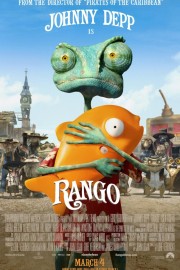Rango
In hindsight, is it really so surprising that Gore Verbinski and Johnny Depp have delivered the most subversive mainstream animated film possibly ever? Look at the facts: Yes, this film has the Nickelodeon logo attached to it. Yes, it has a “family friendly” PG rating. And yes, the trailers make it look like another animated riff on the unlikely heroes genre that also gave us “Shrek,” “Kung Fu Panda,” and “A Bug’s Life.” But look closer: The screenplay is by John Logan, an Oscar-nominated scribe for decidedly adult films like “Gladiator” and “The Aviator.” And Verbinski and Depp may have hit box-office gold with the increasingly-bloated “Pirates of the Caribbean” films, but how soon we forget that Depp’s Captain Jack Sparrow is one of the most outrageous lead characters we’ve ever seen in blockbuster entertainment? And look at the careers of actor and director apart from one another; whether you’re talking about Depp’s collaborations with Tim Burton and Terry Gilliam or Verbinski’s wickedly twisted 1998 “family film,” “Mouse Hunt,” or his criminally underrated 2005 film, “The Weather Man,” it doesn’t take a genius to know these two don’t play by the rules.
Taking these facts into account, it comes as no surprise that “Rango” is confounding both critics and audiences, who no doubt expected one thing and got something completely different. This is not a bad thing. Yes, the film goes on a touch too long at times; and yes, it flies the rails into the type of gonzo surrealism out of which Depp’s hero, Hunter S. Thompson, made a career; but the result is a film that borders on inspired revelation as much as it does out-and-out insanity-driven revolution. I honestly don’t know how it would work without either extreme.
The gonzo starts early, when we meet our hero putting on a production with a female doll missing limbs, a dead insect, and an orange wind-up fish he calls Mr. Tims. He has real creative vision, which will benefit him when the glass tank in which he is housed by his owner flies out of the car and shatters on the old dusty road they’re traveling. Suddenly he’s all alone, and he has a run-over armadillo telling him he must find his path in the desert, which leads him to the town of Dirt, where water has become a rarity and where the townspeople need something to believe in.*
If you’ve seen any amount of Westerns over the years, you can sort of see where this is coming, but one particular kind of Western stands out: the Spaghetti Westerns of Sergio Leone, his “Man With No Name” trilogy with Clint Eastwood, in particular. Although Rango’s shirt and offbeat look is more a nod to the good Dr. Hunter Thompson (who makes an odd sort of animated cameo early on), the film is steeped in the iconography of Leone’s truly original take on the Old West: From the score by Hans Zimmer, which harkens back to Ennio Morricone’s iconic work in the genre (a particular treat for me, as Zimmer and Morricone are my two favorite film composers) to the end credits, which are clearly inspired by the animated credits of Leone’s films, to the characters themselves, which have that distinctly “rough” quality to them (and Rattlesnake Jake is undoubtedly Verbinski’s nod to Leone fave star Lee Van Cleef), “Rango” is a throwback to one of the most outrageous and unusual takes on the Western, and it succeeds beautifully in taking those of us familiar with such films back to the glory days of when Eastwood’s “Man With No Name” was arguably the most unorthodox hero in film. (Funny how that mantle now belongs to Depp’s Sparrow.)
Film fans like myself will enjoy “Rango” more than most; we’ll get the references (which also stretch to the classic ’70s noir, “Chinatown”) and enjoy the film’s aesthetic qualities more than the average viewer. But “Rango” (animated by effects house Industrial Light & Magic in a watershed akin to their work on the first two “Star Wars” films) is far from a misfire by finding its audience in an older demographic. That just makes it stand out more in a movie-going environment that still looks at animation as primarily a kiddie genre. With a greatly talented voice cast (including Isla Fisher, Abigail Breslin, Bill Nighy, Ned Beatty, Ray Winstone, and Timothy Olyphant), a truly unique visual style (Did I mention master cinematographer Roger Deakins was a consultant on the film?), and a one-of-a-kind hero in Depp’s misfit lizard, “Rango” is a triumph of imagination and risk over safe commerce that Hollywood would do right to allow filmmakers like Verbinski to make more often.










